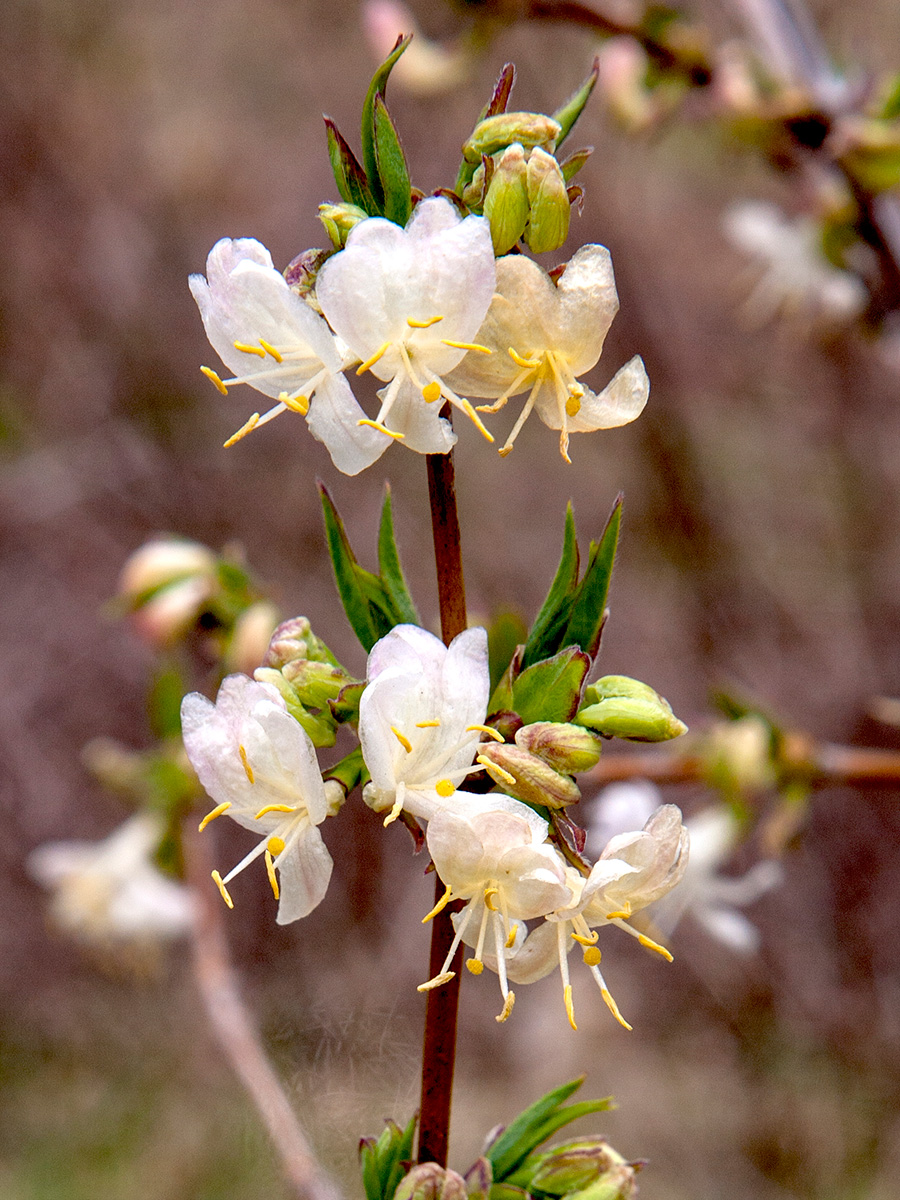
People often stretch the definition of “winter-blooming” to include spring-flowering shrubs such as forsythia (Forsythia spp. and cvs., Zones 3–9) rather than using it to describe plants that realistically bloom when snow is still on the ground. But in the more moderate zones of the Northeast (Zone 5 and higher), there are a few winter bloomers that add real winter interest. A few are even worth trying in colder zones given the frequency of warmer winters.
Most gardeners are familiar with the most common earliest blooming shrubs, which are more easily found at garden centers and nurseries. I would never pass up an opportunity for a nice witch hazel (Hamamelis spp. and cvs., Zones 3–9) or our Northeast native serviceberry (Amelanchier spp. and cvs., Zones 3–9), yet there are a few more uncommon species that are perhaps even more valuable in achieving those surprise pops of winter color.

‘Winter Beauty’ honeysuckle
Lonicera × purpusii ‘Winter Beauty’, Zones 5–9
This honeysuckle is noteworthy for its fragrant flowers that bloom as early as late January and last through February. While the flowers can sometimes look a bit underwhelming in photos, one cannot place a value on their honeysuckle-scented fragrance as it drifts over the snow. An excellent bonus to this shrub is that the cut branches come into bloom in just days when brought indoors in early January.

White forsythia
Abeliophyllum distichum, Zones 5–8
I think many of us have heard of this shrub or seen photos of it in a catalog, but when was the last time you ever came across one in person? Depending on how mild the winter is, flowers can bloom as early as February. These blooms can be enjoyed as early as January if one cuts branches to force indoors. Distantly related to the more familiar yellow forsythia, white forsythia has a similar growth habit, and biannual pruning will encourage the growth of new blooming branches. Plan on each shrub growing 3 to 6 feet tall.

Bodnant viburnum
Viburnum × bodnantense, Zones 5–9
A rarely seen late winter-blooming shrub, Bodnant viburnum will pop into bloom just as the snow melts and before its foliage emerges. This is sometimes in late February in New England and slightly later farther north, but it can be even earlier if the plant is sited in a protected spot near a sunny wall. This is another great shrub to force early in January. The flowers look more like those of a jasmine (Jasminum spp. and cvs., Zones 6–11) than those of a typical viburnum.

February daphne
Daphne mezereum, Zones 4–7
February daphne is a deciduous shrub that produces fragrant pink or white flowers (depending on the cultivar) on bare stems in February or March. This is a true cold-hardy winter shrub that is difficult to find growing in the South. February daphne takes partial shade and grows best in moist, humus-rich woodland soil. It rarely grows taller than 3 to 4 feet. In my Massachusetts garden, I have had some February daphne bloom as early as Christmas or New Year’s Day. Because of this, I like to site these shrubs near doorways or along woodland paths to enjoy their blooms without having to shovel a path. All daphne berries are toxic, so site them carefully if you have small children or pets.

Eternal Fragrance® daphne
Daphne × transatlantica ‘BLAFRA’, Zones 6–9
D. × transatlantica is a cross between Caucasian daphne (D. caucasica, Zones 5–9) and collina daphne (D. collina, Zones 6–9). Perhaps my most favorite winter shrub, D. × transatlantica has the distinction of producing flowers in our garden every month of the year, while its peak blooms are in late spring and again in early autumn. Look for newer named selections such as Eternal Fragrance®, which is often listed as hardy to Zone 6 even though I know of many growing in Northeastern gardens in Zone 5. A deep snowfall will increase its range.
While the entire genus of Daphne is underutilized in our Northeastern gardens, these two early-blooming daphnes, February daphne and D. × transatlantica, are a sensation. Both have a peak bloom time in early March but with the added magic of producing sporadic flowers throughout the year, particularly during mild winters.
—Matt Mattus is a lifelong gardener and vice president of the Worcester County Horticultural Society. He’s written two books: Mastering the Art of Flower Gardening and Mastering the Art of Vegetable Gardening.
Fine Gardening Recommended Products

Pruning Simplified: A Step-by-Step Guide to 50 Popular Trees and Shrubs
Fine Gardening receives a commission for items purchased through links on this site, including Amazon Associates and other affiliate advertising programs.

VegTrug Classic Cold Frame
Fine Gardening receives a commission for items purchased through links on this site, including Amazon Associates and other affiliate advertising programs.

Black and Decker 22-inch Cordless Hedge Trimmer
Fine Gardening receives a commission for items purchased through links on this site, including Amazon Associates and other affiliate advertising programs.
- 38 x 7 x 7 inches
- 6.9 pounds
- 1 Lithium Ion battery required (included)



















Comments
Log in or create an account to post a comment.
Sign up Log in